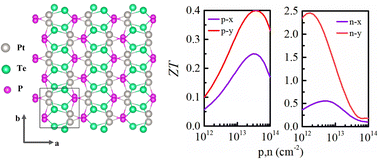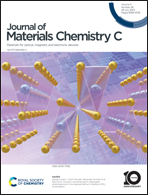Promising novel thermoelectric materials: two-dimensional penta-like PtPX (X = S, Se, Te) nanosheets†
Abstract
Exploring high-power self-charging technologies is essential given the quick development of wearable and implantable devices. Devices that convert body heat into electricity and are based on flexible materials are known as thermoelectric conversion devices. Pentagonal-shaped layered materials have strong electrical structures and mechanical properties and can be used in microelectronic devices. Here, we have reproduced the electrical and thermoelectric transport characteristics of the PtPX (X = S, Se, Te) monolayer based on density functional theory and semi-classical Boltzmann transport theory. At 300 K, the mobility of the carriers in n-type doped PtPS, PtPSe, and PtPTe was very high along the y direction, measuring 1386 cm2 V−1 s−1, 312 cm2 V−1 s−1, and 14 591 cm2 V−1 s−1, respectively. Asymmetric chemical bonds in PtPSe have a high anharmonic impact that prevents heat transfer and leads to low thermal conductivity when compared to PtPS and PtPTe monolayers. We conclude that the highest ZT values of PtPS, PtPSe, and PtPTe at 800 K might be as high as 1.03, 1.26, and 2.47 for p-type doping and 1.23, 1.25, and 5.94 for n-type doping, respectively. It is expected that our findings will provide a direction toward experimental research on the thermoelectric properties of layered metal-based phosphochalcogenides.

- This article is part of the themed collection: 2023 Journal of Materials Chemistry C HOT Papers


 Please wait while we load your content...
Please wait while we load your content...